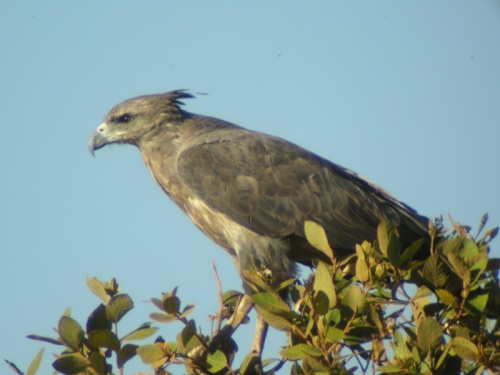(Distribution expanded. Taxonomy. References. Video link) |
(Imp sizes. References updated. Additional GSearch for additional scientific name) |
||
| (8 intermediate revisions by 4 users not shown) | |||
| Line 1: | Line 1: | ||
| − | '''Alternative | + | '''Alternative names: Crowned Eagle, Crowned Solitary Eagle''' |
| − | [[Image: | + | [[Image:Solitary_Crowned_Eagle.jpg|thumb|500px|right|Photo by {{user|birdclub|birdclub}}<br /> [[Emas National Park]], [[Brazil]], July 2010]] |
| − | ;[[:Category: | + | ;[[:Category:Buteogallus|Buteogallus]] coronatus<br /> |
| + | ''Urubitinga coronata'' | ||
==Identification== | ==Identification== | ||
| − | + | 73–85 cm (28¾-33½ in) | |
*Dull slate grey | *Dull slate grey | ||
*Darker wings | *Darker wings | ||
| Line 21: | Line 22: | ||
Classified as endangered in the IUCN Red List due to its small, fragmented population, and population decline due to habitat loss and hunting ([http://www.birdlife.org/datazone/search/species_search.html?action=SpcHTMDetails.asp&sid=3496&m=0 BirdLife International, 2008]). | Classified as endangered in the IUCN Red List due to its small, fragmented population, and population decline due to habitat loss and hunting ([http://www.birdlife.org/datazone/search/species_search.html?action=SpcHTMDetails.asp&sid=3496&m=0 BirdLife International, 2008]). | ||
==Taxonomy== | ==Taxonomy== | ||
| − | This is a [[Dictionary_M- | + | This is a [[Dictionary_M-O#M|monotypic]] species<sup>[[#References|[1]]]</sup>.<br /> |
| + | Formerly placed in the genus ''[[:Category:Harpyhaliaetus|Harpyhaliaetus]]''. | ||
==Habitat== | ==Habitat== | ||
Lowland, seasonally dry palm savanna, sparse woodland and shrubland; chaco; and campo cerrado. | Lowland, seasonally dry palm savanna, sparse woodland and shrubland; chaco; and campo cerrado. | ||
| Line 30: | Line 32: | ||
It builds a large platform nest. A single egg is laid. | It builds a large platform nest. A single egg is laid. | ||
==References== | ==References== | ||
| − | #{{Ref- | + | #{{Ref-Clements6thAug18}}#BirdLife International |
| + | #[http://www.museum.lsu.edu/~Remsen/SACCprop492.html SACC proposal]] for taxonomy including this species | ||
#Wikipedia | #Wikipedia | ||
{{ref}} | {{ref}} | ||
==External Links== | ==External Links== | ||
| − | {{GSearch| | + | {{GSearch|Buteogallus+coronatus}} |
| + | <br /> | ||
| + | {{GSearch|Urubitinga+coronata Use Urubitinga coronata to}} | ||
<br /> | <br /> | ||
{{Video|Crowned_Solitary_Eagle}} | {{Video|Crowned_Solitary_Eagle}} | ||
| − | [[Category:Birds]][[Category: | + | [[Category:Birds]][[Category:Buteogallus]] [[Category:Videos]] |
Revision as of 10:48, 19 August 2018
Alternative names: Crowned Eagle, Crowned Solitary Eagle
- Buteogallus coronatus
Urubitinga coronata
Identification
73–85 cm (28¾-33½ in)
- Dull slate grey
- Darker wings
- Prominent bushy crest
- White band and white tip to dark tail
- Yellow cere
- Yellow legs
Juvenile
- Brown upperparts
- Cream below, cream head and throat
- Dark post-ocular stripe
- Upper breast mottled brown
- Mottled lower belly
Distribution
South America: found in savanna of southern Brazil, Paraguay and Bolivia to northern Argentina.
Status
Classified as endangered in the IUCN Red List due to its small, fragmented population, and population decline due to habitat loss and hunting (BirdLife International, 2008).
Taxonomy
This is a monotypic species[1].
Formerly placed in the genus Harpyhaliaetus.
Habitat
Lowland, seasonally dry palm savanna, sparse woodland and shrubland; chaco; and campo cerrado.
Behaviour
Diet
The diet includes reptiles, small mammals, fish, monkeys and sometimes birds.
Breeding
It builds a large platform nest. A single egg is laid.
References
- Clements, J. F., T. S. Schulenberg, M. J. Iliff, D. Roberson, T. A. Fredericks, B. L. Sullivan, and C. L. Wood. 2018. The eBird/Clements checklist of birds of the world: v2018. Downloaded from http://www.birds.cornell.edu/clementschecklist/download/
- BirdLife International
- SACC proposal] for taxonomy including this species
- Wikipedia
Recommended Citation
- BirdForum Opus contributors. (2024) Chaco Eagle. In: BirdForum, the forum for wild birds and birding. Retrieved 24 April 2024 from https://www.birdforum.net/opus/Chaco_Eagle
External Links




